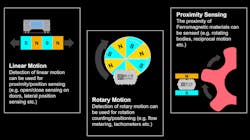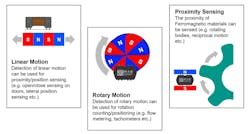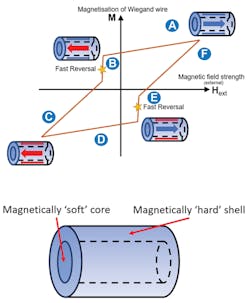New Ways to Put the Wonderful Wiegand Wire to Work
At a Glance:
- What makes the Wiegand effect interesting is that the strength of this pulse is virtually constant.
- Tiny Wiegand sensors, packaged as SMD components, are commonly used in multi-turn encoders for gas and water meter applications.
- An R&D initiative, sponsored by sensor manufacturer Posital and the German ministry of science and technology, aims to significantly increase energy output of Wiegand sensors.
A Wiegand wire is a small piece of ferromagnetic wire with a special—almost magic—characteristic: When a magnetized sample of the wire is exposed to a changing magnetic field (such as the field created by a moving magnet) it will retain its initial magnetic polarity until the external field reaches a certain threshold, then abruptly “flip” to the opposite polarity. This reversal of magnetic polarity takes place within a few microseconds and will induce a pulse of electric current in a fine copper coil wrapped around the Wiegand wire.
What makes the Wiegand effect interesting is that the strength of this pulse is virtually constant, regardless of the rate at which the external magnetic field changes. While simple dynamos are effective at converting rotary motion into electrical energy, their output power depends on rotation speed; when the dynamo turns very slowly, power levels may be too low to be useful. With a Wiegand wire however, the strength of the electrical pulse generated with each change of the magnetic polarity is consistent—no matter how quickly or slowly the external magnetic field changes.
This unique property has made the Wiegand wire useful for a variety of interesting applications. Pulses can be used to precisely mark changes in a magnetic field (rapid or gradual); to generate small—but useful—amounts of electrical energy; or as a source of both signals and energy. Because useful samples of Wiegand wire are so small—less than 1 mm diameter and 15 mm long—it’s easy to devise different relationships between the wire and the magnetic field, including static magnet/moving wire, static wire/moving magnet and static wire/electromagnet connected to an alternating current source.
Wiegand Wire in SMD Housing with Current-Generating Coil
An early commercial application of the Wiegand effect was with access cards for security systems. Short lengths of Wiegand wire were embedded side-by-side in the body of plastic cards. The spacing between these pieces of wire would be different for each card and would spell out a unique binary code. In use, a card would be swiped through a card reader that contained permanent magnets arranged to trigger polarity reversals in the Wiegand wires.
By detecting these polarity changes, the device could read the coded number and decide whether to grant access to the card’s owner. The reader would work effectively regardless of how slowly or quickly the card was swiped. This technology was used successfully for several decades before being supplanted by RFID technology.
Wiegand wires have also been used to trigger rotation counts for gas and water meters. Here, a magnet attached to the shaft of an impeller wheel would trigger polarity reversals—and pulses of electrical energy—in a piece of Wiegand wire. The special advantage of the Wiegand system is that each revolution of the impeller would trigger two distinct electrical pulses, regardless of the rate of rotation.
An extension of this system is used in multi-turn rotary encoders used to measure angular displacements in machinery. In this case, the electrical energy generated by the Wiegand system is also harvested to activate high-efficiency counter circuits. Each complete rotation of the encoder’s shaft is detected and recorded—even when no external power is available. This eliminates the need for backup power from batteries and makes these devices maintenance free.
Wiegand systems can also be used as proximity sensors, where the presence of a large ferromagnetic body distorts the magnetic field around the Wiegand wire enough to trigger a polarity reversal
Advantages of Wiegand Sensors
The Wiegand effect requires no mechanical contact between the source of variable magnetic field and the Wiegand wire assembly. There is no wear and Wiegand systems will function reliably for billions of cycles. With no moving parts on the sensor itself, they are physically rugged and can operate effectively over a wide range of temperatures. In counting applications, trigger events can be differentiated frequencies up to 33 kHz.
Future Developments
Some manufacturers have expressed interest in using Wiegand-based counters to keep track of operating cycles in equipment—such as large industrial doors—where usage history is an important for scheduling predictive maintenance.
At present, the output from a Wiegand wire is modest—about 200 nanojoules of energy for each polarity reversal. A key to extending the usefulness of the technology is a significant increase in power output. An R&D initiative sponsored by the sensor manufacturer Posital and the German ministry of science and technology aims to increase energy output of Wiegand sensors by an order of magnitude. This, combined with the emergence of ultra-efficient electronic chips and low power wireless communications technologies, would open the door to a new generation of energy self-sufficient, maintenance-free instruments that can function as nodes on the Industrial Internet of Things (IIoT)
This could mean thousands of smart sensors distributed throughout a factory, collecting data for process monitoring and optimization. If these devices can harvest the electricity they need directly from the operation or the machinery they are monitoring, there will be enormous benefits in simplifying network deployment and eliminating the need to install, inspect and dispose of a huge number of backup batteries.
Future uses of the Wiegand effect extend beyond sensors and networks. In a totally different area, researchers are exploring the possibility of using Wiegand sensors to recharge batteries in biomedical devices implanted in a patient’s body. Here, an external alternating magnetic field would trigger current pulses in a Wiegand system attached to the battery pack. Because the Wiegand effect operates efficiently over a wide range of frequencies, the alternating magnetic field could be tuned to a frequency that would transmit energy efficiently. This would sidestep a limitation of radio frequency electromagnetic waves that are strongly attenuated by living tissues.
The Wiegand effect is an intriguing option for signal generation and energy harvesting. It is a well-proven technology with unique properties that make it a viable solution for many imaginative new applications.
Tobias Best works at FRABA Pte, Singapore.
The Wiegand Cycle
A. At the beginning of the cycle, the magnetic polarity of the outer shell and the inner core are the same.
B. When the wire is exposed to a moderate external field in the opposite direction, the outer layer of the wire shields the core, and both retain their original magnetic polarity. However, when the strength of the external field reaches a critical threshold, the influence of this shielding effect is overwhelmed and the polarity of the core of the wire will suddenly reverse. This sudden change in polarity creates a current pulse in the coil surrounding the wire.
C. The combination of the strengthening external field and the reversed polarity of the inner core cause the magnetic polarity of the outer shell to reverse as well.
D. As the external field diminishes, the wire retains its new polarity.
E. When the external field (now reversed) reaches the critical threshold, the core material of the Wiegand wire will flip back to its original polarity, producing a current pulse in the surrounding coil.
F. This is followed quickly by a reversal of the polarity of the outer core. The wire is now back in State A.



